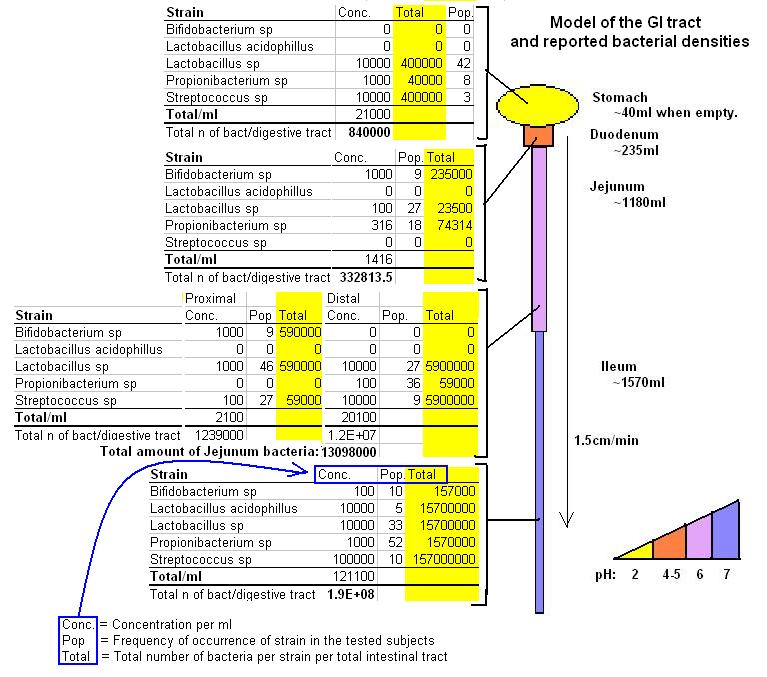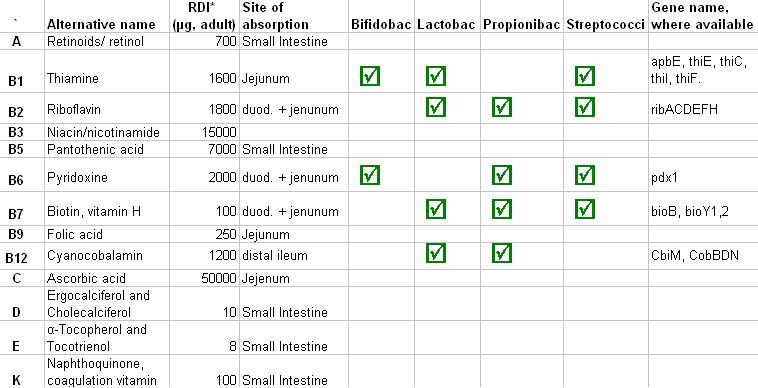Edinburgh/Future
From 2007.igem.org
Introduction | Applications | Design | Modelling | Wet Lab | Proof of concept | Future Directions | References
Sometimes directions on where not to go can be as helpful as directions on where to go. This section deals with pushing the boundary in genetic engineering to the closest thing we can do without modifying ourselves; namely editing our closest symbionts, the gut bacteria.
Contents |
An ulterior motive
We picked Lactobacillus not only because it is food-grade and well received by the public, but also because it is an established part of our gut flora. The majority of research suggests that lactic acid bacteria improve human health in its own right, but genetic manipulation could take this one step further.
Numbers and strains that make up regional gut microbiome were indirectly inferred until August this year, when direct internal sampling data were published. With reference to this paper, we selected the foodgrade bacteria and genomically analysed these for amino acid and vitamin metabolic pathways. Output data was placed in a mathematical model of the gastrointestinal (GI) dimensions that we drew up using textbook and clinical research paper figures.
A 235ml window of opportunity
The GI tract is over 4m long and the first bit, the duodenum, makes up only 6% of the passageway. Absorption of fats, carbohydrates, amino acids and vitamins is all done almost exclusively in the small intestine, but more importantly, metabolites needs to pass the duodenum before being absorbed. This provides a 30cm window to alter metabolic flux. Our calculations show that it contains over 300.000 food grade bacteria.
However we found out that this was not enough to confer significant change to the system.
A worked example: PKU
The duodenal microbiome offers a limited solution to inherited amino acid related diseases. In PKU, phenylalanine (Phe) isn’t broken down into tyrosine (Tyr), so Phe accumulates and Tyr is deficient. This causes ~3g Phe overload and ~3g Tyr deficiency daily, based on a normal western 80g protein diet (these numbers are based on uptake minus a basic Phe tolerance in phenylketournics and incorporates tyrosine's normal percentage conversion into Phe).
Divide and Colonise
Our plan was to take control of the local microbial armies and make them work for us, sweeping up and secreting amino acids in order to reinstall homeostasis. Further it seems like the chorismate pathway could be adjusted to block phenylalanine production, amplify phenylalanine uptake and boost tyrosine production without getting in trouble with aromatic amino acid feedback loops since core enzymes are regulated by summed aromaticity. However, the sheer amount of metabolism that a microbe needs to do to save its host human is too much for the duodenal microbiome; E. coli and Lactobacilli phenylalanine transport kinetics were far from sufficient even at complete saturation. Besides, amino acid metabolics is more complex since peptides are often not entirely monomerised and are preferentially taken up as di- or tripeptides by epithelial cells .
Vitamins
Vitamin-biosynthesis was more promising. The self-flavouring yoghurt pathway features vitamin A precursor beta-carotene, made via enzymes from Pantoea Sp. But GI microbes actually contain innate enzymes that synthesise vitamin B1, B2, B6, B7 and B12. That's half of all required vitamins! Moreover, now there is a larger army of microbes to secrete fewer molecules since only minute (but very important) amounts of vitamin are needed and absorption occurs throughout most of the small intestine. It total, no less than 200 million food grade bacteria are available to see to the tailored needs of people with deficiencies. But further calculation led again to the conclusion that quantity is no substitute for quality, and only vitamin B7 recommendations can probably be achieved, even at such numbers.
B7 keeps the hairs on your head, and while this is all very pretty, we had initially set out to cure major metabolic disorders, so we were disappointed.
Conclusion
So when we conclude that this direction is not advisable, we do so because the numbers don't work out. But we don’t overlook the possibility to treat metabolic ailments in the future, especially if the bacterial kingdom is explored as actively as is encouraged in the iGEM competition. We show our figures so that other teams may measure what production rates they achieve and more easily establish whether they can potentially remedy a metabolic disorder, or not.
... Location, location, location
Above closure depends on the absence of enough manipulatable microbial army in the right region. But there are a few noteworthy special cases. The guinea pig GI tract consists almost entirely of Lactobacillus. The bumblebee's is completely Bifidobacterial, as is the human infant’s. There may be opportunities here that are otherwise not achievable.
Introduction | Applications | Design | Modelling | Wet Lab | Proof of concept | Future Directions | References

